
TORONTO — The Toronto Raptors jumping the gun on the trade market has done this annual column a bit of a disservice. While it remains, in my estimation, a useful tool to bookmark for the weeks leading up to the Feb. 8 NBA trade deadline, this transaction season feels a little less intense, given the Raptors have already made the two biggest moves they, and perhaps anyone, will make.
So, we’ll save the Silverstein references for 2025 and get right down to business.
A year ago at this time, the Raptors dealt a first and two seconds for Jakob Poeltl. The year prior, it was a first for Thad Young and a second. And, more instructively, in 2021 they turned Norman Powell into Gary Trent Jr. and superfluous soon-to-be free agents Matt Thomas and Terence Davis II into mid-second round picks. There’s always room for additional tweaking under the headline items, even if it’s not sexy.
What is sexy is complying with the collective bargaining agreement. What follows is an explanation of the different assets the Raptors have available to them, the CBA rules regarding trades, and other areas for clarification that people historically ask about.
League-wide asset sheet
As I prepare for the deadline every year, I put together a spreadsheet of all of the relevant information for each team in the league. The sheet — which you can access here — includes trade exceptions, details about team tax and hard-cap situations, draft rights, picks and contracts. It can be a bit overwhelming (there’s a legend on the right-hand side), so don’t sweat the volume. If you’re looking for, say, a team that has a modest trade exception and spare second-round picks, or a team with a large expiring salary and a first available to them, hopefully it helps.
The Raptors’ current and future cap sheet
I reset some of the Raptors’ cap situation after the OG Anunoby and Pascal Siakam trades, so we’ll just refresh quickly here.
Everything is fairly straightforward this year. The Raptors have a full roster, they’re far enough below the luxury tax threshold that they won’t have to worry about crossing it in most trade scenarios, and they maintain some flexibility to cut players post-deadline if they’d prefer to take a look at a G Leaguer or other free agent.
The long-term view here is more relevant. The Raptors have only seven players under contract for next year at $88.8 million total, well below the projected $142-million cap level. A $23-million team option on Bruce Brown and a new deal for Immanuel Quickley could take up most of that potential cap space, but Quickley has a small “cap hold” as a free agent that could let the Raptors be spenders in free agency and then circle back to re-sign Quickley to a new deal later, a helpful wrinkle when you have good, young restricted free agents.
As currently constructed, the Raptors could find their way to $36 million in cap space without much sweat, they’d just need to find a home for Brown (by declining his option or trading him). Trading Chris Boucher or Dennis Schroder by the deadline could free up more flexibility. And even if you don’t love this summer’s free agent class, cap flexibility can be valuable by letting you be opportunistic in trades with teams that need space or to lower their luxury tax bill in a new, stricter CBA environment that arrives for 2024-25.
They have prioritized flexibility at most junctures the last few years, and I’d expect anything they do at the deadline to maintain that flexibility, or even increase it. Removing Anunoby and Siakam’s free agencies has clarified things in this regard. The Raptors would probably need to get a significant draft pick or a player they see as part of the long-term future to eat into that flexibility.
Luxury tax
The Raptors are $4.8 million below the luxury tax, and that number is really more like $9 million. That’s because several Raptors have “unlikely incentives” that we have to count toward the tax level right now, to be safe, but won’t count at the end of the season unless they’re achieved. As the name suggests, these are all unlikely.
Having $9 million in wiggle room under the tax means the Raptors can negotiate in trade without concern about going into the tax, allowing them to take on additional salary. That can be helpful just in mechanically structuring a trade that’s cap-legal, or to pick up an asset to help a team get out of the luxury tax.
Kira Lewis Jr., for example, was acquired by Indiana to help the Pelicans get out of the tax, and they were able to use him to make the Siakam trade work and recoup a second-round pick.
The Raptors could also technically go into the tax if the right deal came along. It is hard to picture what that deal might be, given they’ve been a tax-paying team only in their championship season and since trades have to fit within the rules (and thus can’t be pure salary dumps).
Other tradable assets
In addition to players, the Raptors have other tools available in trade.
Cash: Teams can send and receive $7.01 million in total this league year, which runs until June 30. The Raptors haven’t sent or received any cash yet, so that full amount is still available to them.
Draft picks: The Raptors have picks again! Before the Pacers trade, the Raptors were pretty hamstrung on what they could offer in draft equity. That’s because the pick they owed to the Spurs technically tied up four years’ worth of firsts and two years’ worth of seconds, because of the way the protections rolled over and the limits on trading consecutive firsts, even theoretically. That’s no longer an issue.
The Raptors now have their own firsts from 2024 to 2030, save for whatever first they ultimately convey to the Spurs. (That pick is top-six protected through 2026, then becomes two seconds if it isn’t conveyed.) They also have Indiana’s first this year, top-three protected, and the lowest first-round pick among the group of the Thunder, Jazz, Clippers and Rockets. Toronto also holds an additional 2026 first from Indiana, top-four protected, and it picked up Detroit’s 2024 second-round pick in the Anunoby deal. (2025 is the only year the Raptors don’t own some second-round pick.)
Toronto’s appetite for dealing picks is probably minimal unless it helps it land a good, young player, but it’s helpful to have them as currency.
I should note here that the market value of draft picks could shift in some corners of the league with stricter rules for high-tax teams. Finding inexpensive players is going to be even more important as the league takes roster-building tools away from those teams, and a new CBA wrinkle allows teams to sign their own second-round picks to three- and four-year contracts without dipping into their free agency exceptions, which never used to be the case.
As an example of these effects, Denver traded a more valuable future first-round pick to Oklahoma City last year for two immediate second-round picks, giving up upside to secure inexpensive depth that could contribute to a championship window without blowing out the tax bill. Those trades could become a bit more common these next two summers, and in general, there might be a shift in how much teams (like Toronto this summer) can command for their extra draft picks or to take on contracts in trade.
Player rights: This has replaced Nando De Colo’s restricted free agent rights as my favourite weird CBA wrinkle that remains active. (RIP my De Colo bit.) The Raptors hold the draft rights to DeeAndre Hulett, a 2000 draft pick who never saw the NBA. These rights still hold a sliver of value because NBA rules dictate that each side has to send something in any trade, and so outdated draft rights can work as a sort of currency. Every team in the NBA except Philadelphia holds draft rights on some outdated player, in case they need to throw in some nonsense in a trade, so it kind of makes you wonder why we keep this wrinkle around.
Trade restrictions
Every player on the Raptors is eligible to be traded. However, all of the new players can’t be aggregated in a trade. That means you can’t pair their salary with another player’s to make the cap math work. Brown, Lewis, Quickley, RJ Barrett and Jordan Nwora can all be traded, but only solo, for cap-math purposes.
Exceptions
There are three exceptions teams can use to get around the salary-matching rules in trades.
Disabled Player Exception: Teams can apply for one of these if they lose a player for the year. The Raptors do not have one. For those who asked before he was waived, requesting a DPE for Christian Koloko wouldn’t have done anything for the Raptors, as it’s purely a cap-space tool; you do not get an extra roster spot, and the Raptors needed to waive someone to clear a roster spot.
Minimum Player Exception: Teams are always permitted to acquire minimum-salary players, as long as they have the roster space and wouldn’t exceed the hard-cap, if they are a hard-capped team. (The Raptors are not.)
Traded Player Exception: A traded player exception allows a team to take back a salary that matches an existing exception, plus $100,000, without sending matching salary out. The Raptors have a $10.17-million trade exception from the Siakam trade that they could use to absorb $10.27 million in salary, up until Jan. 17, 2025.
These exceptions can’t be combined with each other or combined with player salaries. That is, the Raptors can’t take their $10.17-million TPE and a $3-million player salary to take back a $13.17-million player, they could only take back a $10.27-million salary.
Salary matching
There are three sets of rules for salary-matching in trades, depending on where you fall in terms of the salary cap, luxury tax and luxury tax aprons. There will be even more complications (and sub-tiers) to this starting next year. For now, the three ranges are as follows.
Teams above the first apron (GS, LAC, BOS, PHX, MIL, MIA, DEN): These teams can take back 110 per cent more in salary than they send out.
Between tiers (PHI, LAL): These teams technically belong to the group below but any trade that takes on too much additional salary will push them to the apron-level rules. Basically, for these teams, the rules are, “It depends how big the trade is.”
Teams above the cap but below the first apron (CHI, CLE, MIN, DAL, TOR, POR, BRK, ATL, MEM, OKC, SAC, WAS, HOU, SA, IND, NO, UTA, CHA, NY): These teams are operating under the old rules, with a bit of additional flexibility. The amount of salary you can take back depends on how much you send out.
Teams below the salary cap (ORL, DET): Neither team has enough cap space to absorb a meaningful player, but being below the cap offers some flexibility, like the Pacers acquiring Lewis to use in a subsequent trade (something you can’t do as an above-cap team). The rules from the above group will hold if Orlando or Detroit make a large enough trade that they move above the salary cap.
The Raptors are operating as an above-cap, below-apron team, so they have plenty of room to add extra salary. The bigger question is, what teams have to send them to acquire their players. Below are some examples.
There are additional rules to keep an eye out for with other teams, like no-trade restrictions, poison-pill provisions, trade kickers and more. The Raptors do not have any players who fall into those categories, but the sheet linked off the top includes that information in case it’s relevant to your trade target of choice.
Two-ways
Two-way contracts are allowed to be traded. They don’t count for salary matching and can’t create a trade exception, nor do they count against the cap or tax.
The NBA loosened the rules for two-way player availability over the course of the last few seasons, and the Raptors aren’t playoff-bound, so they won’t need to worry about converting a two-way to a standard contract by the end of the year.
You may choose to do that anyway, to sign a player through 2024-25 or reward him for a good season, but it’s not urgent. In addition, you can sign that player to a longer deal in July than you could in-season, so it may be beneficial for both sides to wait, in some cases. Jontay Porter, for example, could be converted to make sure he’s eligible for the play-in game, if the Raptors make one, and to sign him for next season. The Raptors can’t go beyond that contract length because they don’t have any of their mid-level exception left, and that’s required to sign a contract beyond two years (unless the player was your second-round pick). If they wait until July 1, however, they could sign him to a four-year deal instead.
The TL;DR version
*The Raptors’ new players can be traded away, but they can’t be aggregated with other players for salary matching.
*The Raptors have an estimated $9 million in space beneath the luxury-tax line. They can take on significant additional salary for this year without tax concerns, offering another potential path to picking up assets by taking on money. It’s unlikely they sacrifice future cap flexibility unless it’s for a very spicy asset.
*The NBA-wide market for extra draft picks and renting out your cap space could be changing as more restrictive CBA rules come in. Flexibility and extra assets may allow a team to be more opportunistic than in past summers. The degree to which this will have an impact remains to be seen.
*“Flexibility” will be as big a buzzword as “patience” in these parts for the next 18 months, or until a player worth sacrificing that flexibility for comes along.
*The Raptors have a $10.2-million trade exception they can use to acquire a player without sending out salary. It can’t be combined with other player salaries.
*The trade deadline is Feb. 8 at 3 p.m. ET / noon PT.











